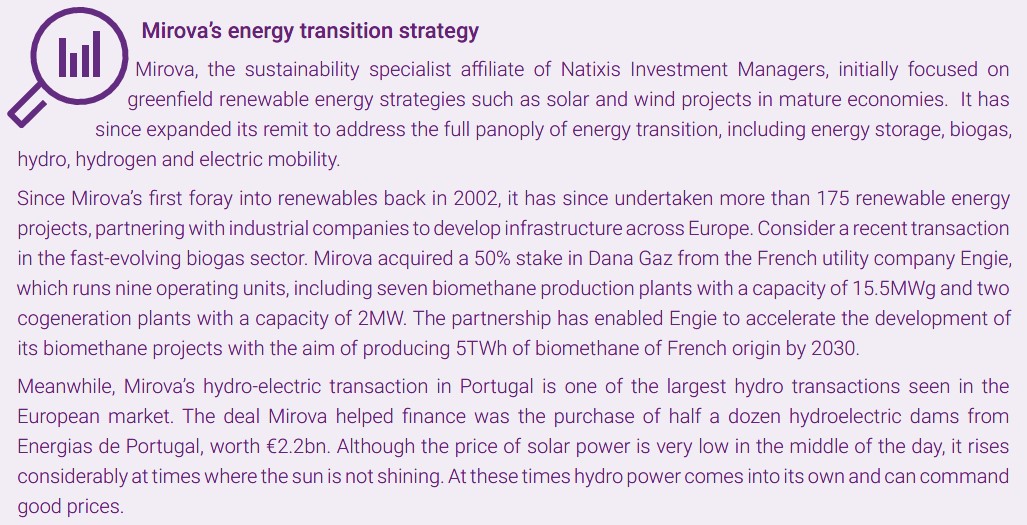Energy Transition: Matching Liabilities and Capturing the Equity Premium
Highlights
- An allocation to infrastructure equity can lift portfolio yield by reducing volatility compared to listed equity, better matching assets to liabilities and improving a scheme’s sustainability profile.
- Energy transition infrastructure is little different to traditional infrastructure assets such as bridges and hospitals: income from well-structured energy transition infrastructure assets is predictable and can match liability cashflows.
- Sponsors, too, take a positive view on the inclusion of energy transition assets in their DB pension scheme allocations. This desire means trustees and sponsors are often driving the shift in allocations, rather than their local advisors.
That asset class? energy transition infrastructure.
How Renewables are a Fit for DB Schemes
As an illiquid asset, energy transition infrastructure is not suitable for many types of investors, but for defined benefit schemes the rationale is strong.
Pension funds are adept at discounting the cashflows relating to the retirement dates of their members, and have widely deployed liability-driven investments to match these expected cashflows. However, as liquid assets become too expensive or too scarce, so schemes have looked elsewhere with illiquid assets, such as infrastructure, used by a growing number of schemes. Energy transition is little different to traditional infrastructure assets such as bridges and hospitals: income from well-structured energy transition infrastructure assets is predictable and can match liability cashflows.
While illiquid debt – as an alternative to liquid debt – is suitable for the purpose, infrastructure equity can be equally suitable. Equity has the advantage of providing higher risk-adjusted returns than debt over the long term.
Most defined benefit pension schemes are used to managing equities as a way of boosting the risk-seeking components of their portfolios. Equity allocations, however, are constrained by volatility, which has the potential to derail a scheme’s funding targets. The huge and unexpected plunge in equity valuations in the first half of 2020, when the COVID-19 pandemic exploded, is just one example of highly-disruptive volatility. Although valuations subsequently recovered, a long period of decline can create headaches for sponsors and pose existential risks to both sponsor and scheme.
“An illiquid equity strategy can offer similar levels of returns to listed equities, but with considerably lower volatility,” says Thomas Benoist, director, head of French corporate sales at Natixis Investment Managers International. “A energy transition infrastructure strategy can both increase portfolio diversification and decrease scheme risk.”
Not least, energy transition infrastructure can satisfy the preferences of sustainably-minded scheme members, can help meet increasing regulatory demands around carbon reduction, and confer wide societal benefits.

Allocation Decisions are Evolving
As the advantages of illiquid energy transition infrastructure become clear, so allocation decisions are evolving.
Globally, pension schemes in developed markets are becoming comfortable with illiquid investments and many have allocations to broad infrastructure strategies. This familiarity means schemes are willing to invest in more niche infrastructure strategies to both increase their exposure to energy transition assets and improve the risk-return of their portfolios.
Sponsors, too, take a positive view on the inclusion of energy transition assets in their DB pension scheme allocations. This desire means trustees and sponsors are often driving the shift in allocations, rather than their local advisors.
“Some advisors we talk to are revising their buy lists and adding more illiquid energy transition strategies to these lists,” says James Lindsay, director UK corporate DB and Insurance at Natixis Investment Managers UK.
Catalysts for Change
This was the case with a UK defined benefit scheme, which allocated more than €50m to Mirova’s energy transition investment strategy earlier this year. The scheme was making its first energy transition energy investment, encouraged by its French parent company which has pledged to become a net zero carbon emissions producer by 2035.
“The key motivators were financial benefits and achieving a strong sustainable footprint,” says Benoist. “The Mirova strategy clearly matched these two objectives.”
The scheme was already well-funded, with a strong LDI book, so its investment consultant had to be satisfied that the strategy was robust, makes a genuine sustainable impact and is also sufficiently diversified. “One of the issues was that the portfolio is European-focused rather than global,” says Lindsay. “But the assets are well-diversified across Europe – which is far from homogenous – and by type, and this was sufficient. “
Stand by for Next-Generation Sustainability
Evolution is natural in pensions, as market structures change and social constructs shift. The growing interest in energy transition infrastructure assets, a key plank in the battle against climate change, is a good example of how financial and societal needs intersect.
In a forthcoming article, we examine how evolution can become revolution, as schemes invest in illiquid sustainable strategies that have not been hitherto considered financial assets. Stand by for next-generation sustainability.
Published in February 2022.
Natixis Investment Managers is a subsidiary of Natixis.
Portfolio management company – French Public Limited liability company
RCS Paris n°453 952 681
Registered Office: 43, Avenue Pierre Mendes France – 75013 – Paris.
www.im.natixis.com
This communication is for information only and is intended for investment service providers or other Professional Clients. The analyses and opinions referenced herein represent the subjective views of the author as referenced unless stated otherwise and are subject to change. There can be no assurance that developments will transpire as may be forecasted in this material.
Copyright © 2022 Natixis Investment Managers S.A. – All rights reserved





 Why Has Making an Impact Been Made so Hard?
Why Has Making an Impact Been Made so Hard?
 Opportunities in Next-Generation Energy Infrastructure
Opportunities in Next-Generation Energy Infrastructure